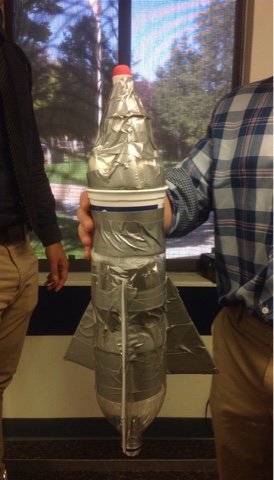Period 2 Physics
Materials
1. 2 2-liter soda bottles: $4
2. Cardboard box: free
3. Trash bag: free
4. Cotton balls: $3
5. Duct tape: $3
6. Shuttlecock: $.50
7. Fishing line: $4
Procedure
1. First, cut one of the two liter bottles at two inches from the bottom and four inches from the top. You should be left with an open cylinder and two smaller pieces from the top and bottom.
2. Take the cylinder from the first bottle and slide it over the bottom part of the second 2-liter bottle so that it extends over about 5 inches. Secure the two pieces together with tape.
3. Next for the fins, cut out three equal triangles from the cardboard box and tape them onto the body of the rocket. Make sure they are straight, equally spaced, and completely covered and secured in tape.
4. For the egg pod, take the two other parts from the 2-liter bottle and put them together to make a dome like structure. Fill this pod with cotton balls so that it pads the egg.
5. Pierce the cap of the pod so that there is a hole later to put the parachute through.
6. Tape the shuttlecock onto the top of the pod (bottom of the cut 2-liter bottle) so that it forms a nosecone like structure.
7. Finally for the parachute, cut out a 20” diameter circle from the trash bag.
8. Cut four, 36” pieces of fishing line and attach them to the edges of the trash bag with duct tape. Make sure the lines are spread out evenly.
9. Bring all of the lines together and thread them through the hole that was made in the cap of the pod. Tape the ends of the string together with duct tape so that they do not slide through the hole.
10. Pack the parachute into the cylinder part of the rocket that extends out and then place the pod into the cylinder so that the nose cone sticks out and is at the top.
Results
Overall, our rocket met all of the requirements as it flew to the required 75ft. At the peak of the flight, the pod separated from the body of the rocket and the parachute extended as the pod floated back down without the egg breaking. Our rocket was one of the only ones that completed all of the requirements. Other groups’ rockets flew much higher but did not save the egg. Other groups didn’t go as high but saved the egg, so our group was a good equilibrium. The wind affected the height of the rocket along with the launching mechanism because the launcher would not release our rocket when the string was pulled.
Conclusion
Although it fit the requirements, the design of the rocket could have been better. The pod of the rocket could have been better secured into the cylinder so that it did not move around as much. Also, the nose cone could have been a sharper point and more streamline so the high of the flight would increase. Furthermore, the shape of the rocket could have been more cylindrical to make it more air resistant. I believe the conditions for the launch could have been better as it was windy during the launch and affected the trajectory of the rocket.
Calculations





No comments:
Post a Comment